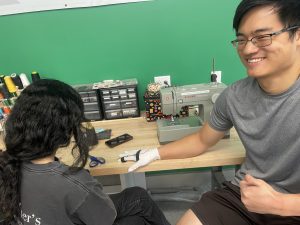Our team spent our meeting time reviewing each other’s writing on the design report and discussing more details about the content we are including in it. After receiving feedback on our design review slides, we realized that there are a lot of things we still had to churn out, so we effectively spent our time ironing out all of the gaps in our design and transferred that into writing for the report. Things like resistor values, how we will digitize our data, and more detailed testing and validation are a few of the important things we refined. These changes did not incur any additional cost.
The most significant risk right now to our project is not meeting deadlines and having good time management. We now have a clear plan of how we want to execute our design, and we have to stay diligent and move forward and meet all of the deadlines. It sounds trivial to just say “we have to stick to our schedule,” but trusting our design process (adjusting as necessary) and being very methodical is what will allow us to do that. From a technical standpoint, a potential risk for our project is our sensor data not giving our ML model enough data. In that case, we would have to order more sensors and wait for those to arrive. We will experiment with our model to find out the outcome of this, but till then we will just be aware of this risk.
We have not made any changes to our schedule, and hope to make significant progress on Rapid Prototype I with all our parts finally in one place.
ABET Questions:
A was written by Somya, B was written by Ria, C was written by Ricky
Part A: Our project heavily requires the consideration of a global context, because at its heart is the pursuit of better communication, which is a goal that is universal regardless of what language is spoken. There’s some grounding in the fact that even though there are hundreds of languages, there will always be the challenge of making communication between deaf and non-deaf persons as easy as possible. We quickly learned that sign language is also not a universal language—there are somewhere between 138 to 300 variants of sign languages that exist. This information should be factored into the design of our product in the sense that it should be as adaptive and as sensitive as possible. The ultimate end goal would be for any deaf person to slip on these gloves and be able to sign in their own version of sign language, and communicate with someone who may not even speak that language. In essence, it would be just like how Google Translate works, but now with an entire additional layer of recognizing global needs by having that language barrier be extended to not just which country that language is, but the form of the language itself.
Part B: From our previous analysis of cultural factors, we have adapted our design to be a bit more equitable for users by having the speaker mounted on the glove and not the computer on the final design. We understand that it would be cumbersome to have a deaf speaker have to prop up a laptop or take out a phone when trying to communicate so we want to make that process as seamless as possible. We also want to use a haptic feedback system instead of an LED feedback system for the same reason, maintaining eye contact with someone you are conversing with is something that people should not have to give up just to use our product.
Part C: Our product doesn’t directly require a heavy consideration of environmental factors, but does so in a few more indirect ways. Right now, since our main goal is to just develop the glove and have it work, the cost is more on the back burner—we are perfectly fine with spending $200+ on all the different components and aren’t too focused on the materials, more so that the materials work. But later down the line, the material choice and cost we do want to more closely consider, because we want our product to be as accessible as possible. This ties into a discussion on natural resources, because we want our product to be easy to manufacture and not require a super complicated and environmentally taxing production process. Our choice of final material for the glove should also be biodegradable and be able to be resistive enough against everyday wear and tear so the user doesn’t need to keep buying them, thus offloading environmental waste.






 . Lastly, I finished all my tasked sections for the Design Report that was due last Friday.
. Lastly, I finished all my tasked sections for the Design Report that was due last Friday.